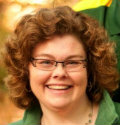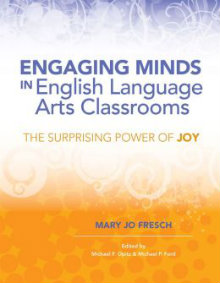The Surprising Power of Joy in ELA Classrooms
Engaging Minds in English Language Arts Classrooms: The Surprising Power of Joy
By Mary Jo Fresch
(ASCD, 2014 – Learn more)

“Rather than simplifying and restricting what we teach, we must open the world of real learning and wonderment to all students.” (p. 45)
With the ever-increasing challenge of meeting the needs of every learner, it is refreshing to find a book that not only gives practical suggestions for keeping students attentive, thoughtful, and inquisitive in the learning process, but does so with the added bonus of a focus on joy!

The book is set up in an easily digestible format and includes a myriad of reference charts for visual learners such as myself.
Introduction
This sets up the rest of the book, explaining the importance of teaching with enthusiasm, making content count, honoring the need for humans to be story tellers, challenging students appropriately, and inviting students to continue the conversation.
Chapter 1 – Understanding Joyful Learning in the English Language Arts
This chapter provides research about how and why we must engage students in their learning. If we make students feel safe, they are naturally motivated to participate and will taste success. I was struck by the simple concept of making the classroom a place of energy and excitement, stimulation and anticipation – of teachers taking pleasure in time spent learning with students. This has long been the mark of a great teacher! Students in these classes participate with enthusiasm and remain on task with little need for redirection.
Chapter 2 – Assessing and Evaluating Joyful Learning
The author discusses how to evaluate the five elements of learning (the learner, the teacher, text and materials, assessments, and school wide configurations), and leads us to examine our own use of the six areas of English Language Arts: reading, writing, speaking, listening, viewing and visual representation.
Practical suggestions are included for assessing students as well as organizing for effective instruction. Differentiation does not have to be overwhelmingly complex. Fresch paints an excellent picture of a classroom where students use self-assessment with confidence and are able to use their assessments to improve upon their work.
Chapter 3 – Implementing Joyful Learning
This chapter offers a virtual goldmine of activities and strategies to engage elementary, middle and high school learners. And the emphasis here is not merely on English Language Arts strategies – but cross-curricular skills that students will use throughout their school careers and their adult lives.
Chapter 4 – Using Joyful Learning to Support Education Initiatives
The book ends with a chapter devoted to contemporary issues of concern to teachers, such as how joyful learning addresses the Common Core State Standards, how we can meet the needs of diverse learners, and how we can address the achievement gap and still keep the joy in learning. I appreciated the reminder that the standards describe what we teach, not how we teach.
I was especially appreciative of the continuous reinforcement of the need for visual representations in our classrooms. This is beneficial not only for our English Language Learners, but for all learners. Another pleasant surprise was the constant reminder to look for students’ strengths, however subtle they may appear to be, and celebrate them.
This is a quick and easy read and will inspire and motivate teachers. With a well-structured book study group or with instructional coaching support, joyful teaching and learning could very well become an addictive habit for teachers.
Rachael Harms is the Professional Development Coordinator for Salem-Keizer Public Schools in Salem, Oregon. She began her career as a middle school choral director and elementary music teacher, then moved into full time classroom teaching, and eventually became an instructional coach. She is currently pursuing her Doctor of Education degree through George Fox University. She lives in Salem with her husband, three teens, and a menagerie of pets.

































